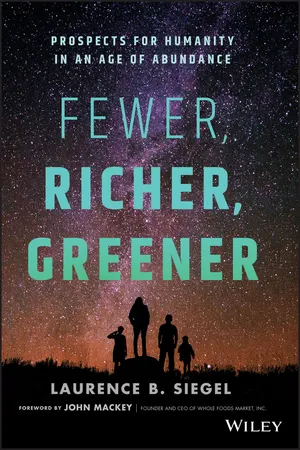
- English
- ePUB (mobile friendly)
- Available on iOS & Android
About This Book
How the world has become much better and why optimism is abundantly justified
Why do so many people fear the future? Is their concern justified, or can we look forward to greater wealth and continued improvement in the way we live?
Our world seems to be experiencing stagnant economic growth, climatic deterioration, dwindling natural resources, and an unsustainable level of population growth. The world is doomed, they argue, and there are just too many problems to overcome. But is this really the case? In Fewer, Richer, Greener, author Laurence B. Siegel reveals that the world has improved —and will continue to improve—in almost every dimension imaginable.
This practical yet lighthearted book makes a convincing case for having gratitude for today's world and optimism about the bountiful world of tomorrow. Life has actually improved tremendously. We live in the safest, most prosperous time in all human history. Whatever the metric—food, health, longevity, education, conflict—it is demonstrably true that right now is the best time to be alive. The recent, dramatic slowing in global population growth continues to spread prosperity from the developed to the developing world. Technology is helping billions of people rise above levels of mere subsistence. This technology of prosperity is cumulative and rapidly improving: we use it to solve problems in ways that would have be unimaginable only a few decades ago. An optimistic antidote for pessimism and fear, this book:
- Helps to restore and reinforce our faith in the future
- Documents and explains how global changes impact our present and influence our future
- Discusses the costs and unforeseen consequences of some of the changes occurring in the modern world
- Offers engaging narrative, accurate data and research, and an in-depth look at the best books on the topic by leading thinkers
- Traces the history of economic progress and explores its consequences for human life around the world
Fewer, Richer, Greener: Prospects for Humanity in an Age of Abundance is a must-read for anyone who wishes to regain hope for the present and wants to build a better future.
Frequently asked questions
Part I
The Great Betterment
1
Right Here, Right Now

The Charming Little House

A Tale of Three Authors
Table of contents
- Cover
- Title Page
- Copyright
- Foreword
- Preface
- Acknowledgments
- Part I The Great Betterment
- Part II Fewer
- Part III Richer
- Part IV Explorations
- Part V Greener
- Afterword
- Reader’s Guide: Annotated Suggestions for Further Learning
- References
- Index
- End User License Agreement